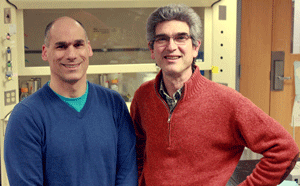 |
|
| Manuel Garber, PhD, and Jeremy Luban, MD. |
Jeremy Luban, MD, and Manuel Garber, PhD, will be principal investigators on a three-year, $6.1 million grant to develop a model for predicting whether a given gene will be turned on or off under specific conditions. Funding for the grant comes from the recently launched Genomics of Gene Regulation (GGR) program at the National Human Genome Research Institute (NHGRI), part of the National Institutes of Health. In total, $28 million in new grants aimed at deciphering the language of gene expression were awarded.
“Why a certain gene is expressed in a specific cell at a given time is an essential biological question that is fundamental to our understanding of life and disease,” said Dr. Luban, the David J. Freelander Professor in AIDS Research and professor of molecular medicine. “This grant will help us decipher the rules that govern gene expression. Ultimately, such information will help explain why one person survives a viral infection and another person does not.”
Dr. Garber, director of the Bioinformatics Core and associate professor of molecular medicine said “Understanding of the regulatory code network—the DNA elements that control when and for how long a gene is expressed—has been elusive. The work we’ll carry out in this project will allow us to model and test the regulatory code of dendritic cells. As a result, we would be able to predict the impact of mutations that do not directly affect the gene product but that affect how and when the gene is made.”
Over the past decade, new scientific evidence suggests that genomic regions outside of the primary protein-coding regions of our DNA harbor variations that play an important role in disease. These regions contain elements that control gene expression and, when altered, can increase the risk for a disease.
The GGR grants will allow researchers to study complex gene networks and pathways in different cell types and systems. The resulting insight into the mechanisms controlling gene expression may ultimately lead to new avenues for developing treatments for diseases affected by faulty gene regulation, such as cancer, diabetes and Parkinson’s disease.
“There is a growing realization that the ways genes are regulated to work together can be important for understanding disease,” said Mike Pazin, PhD, a program director in the Functional Analysis Program in NHGRI’s Division of Genome Sciences. “The Genomics of Gene Regulation program aims to develop new ways for understanding how the genes and switches in the genome fit together as networks. Such knowledge is important for defining the role of genomic differences in human health and disease.”
Luban and Garber will be working with UMMS colleagues Job Dekker, PhD, co-director of the Program in Systems Biology and professor of biochemistry & molecular pharmacology; Oliver Rando, MD, PhD, professor of biochemistry & molecular pharmacology; and Scot Wolfe, associate professor of biochemistry & molecular pharmacology, to develop a model system for exploring gene regulation using human dendritic cells.
The dendritic cell is a key part of the innate immune system that distinguishes self from non-self and, when appropriate, directs the body to attack invading pathogens. In their immature state, dendritic cells help prevent autoimmunity by keeping the immune system’s T-cells from attacking the body’s own cells. When an immature dendritic cell encounters a pathogen, though, a developmental switch is activated and the cell undergoes profound changes in gene expression as it matures. In contrast to immature dendritic cells, the mature cells elicit a potent immune response from T-cells that targets the pathogen.
Luban, Garber and colleagues will examine the changes that the dendritic cell undergoes when it encounters a pathogen and moves from the immature to the mature state. Among the factors they will look at are the genes that are turned on and off during this process. They will examine changes in transcription factors, chromatin modifying enzymes and the cis-acting DNA elements. Linking these elements to specific changes in gene expression should provide a model for predicting the expression of specific genes in dendritic and other cells.
“When the developmental switch in dendritic cells is flipped, the response is huge,” said Luban. “There are many genes involved and it happens quickly, in just a few hours, which makes it an ideal cell model for studying gene expression.”
Among the many things researchers can gain from a predictive model of gene expression is a clearer idea of what factors contribute to a risk for cancer, as well as a better understanding of why vaccines for some pathogens are successful while others are not.
“Knowing the interconnections of these regulatory elements is critical for understanding the genomic basis of disease,” Dr. Pazin said. “We do not have a good way to predict whether particular regulatory elements are turning genes off or activating them, or whether these elements make genes responsive to a condition, such as infection. We expect these new projects will develop better methods to answer these types of questions using genomic data.”
“When you’re given a vaccine you receive the specific antigen that the immune system must respond to, as well as other molecules that stimulate dendritic cells to mature,” said Luban. “While we have some very successful vaccines, in most cases we do not understand the underlying genes and mechanisms that establish the protective immune response. If we better understood how an effective vaccine works, we might be able to engineer a vaccine that prevents infection with HIV-1 or other viruses that have so far eluded investigators.”